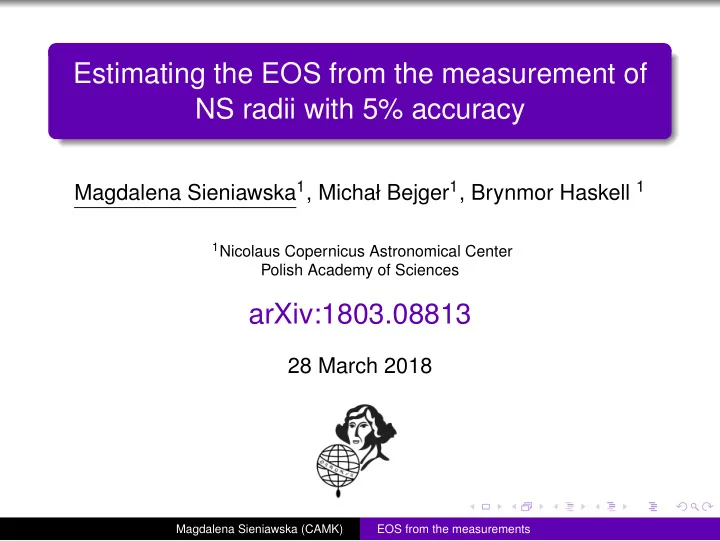

Estimating the EOS from the measurement of NS radii with 5% accuracy Magdalena Sieniawska 1 , Michał Bejger 1 , Brynmor Haskell 1 1 Nicolaus Copernicus Astronomical Center Polish Academy of Sciences arXiv:1803.08813 28 March 2018 Magdalena Sieniawska (CAMK) EOS from the measurements
Why do we need measurements of the global parameters of NSs? There is a strong connection between mass-radius relation and properties of the interiors of the compact objects: cold matter equation of state (EOS) might be reconstructed from measured masses and radii. Magdalena Sieniawska (CAMK) EOS from the measurements
Measurements of masses Özel & Freire 2016 Magdalena Sieniawska (CAMK) EOS from the measurements
Theory - a plethora of EOSs Özel & Freire 2016 Magdalena Sieniawska (CAMK) EOS from the measurements
Challenges in modern NSs measurements We need better estimations of NSs global parameters. → Advanced Telescope for High ENergy Astrophysics (ATHENA) & Neutron star Interior Composition ExploreR (NICER) → Predicted accuracy of M and R measurements: few % by using pulse profile modelling Psaltis, Özel & Chakrabarty (2014); Psaltis & Özel (2014); Lo, Miller, Bhattacharyya & Lamb (2013); Miller & Lamb (2016) Magdalena Sieniawska (CAMK) EOS from the measurements
Challenges in modern NSs measurements Pulse profile modelling limitations Watts et al. 2016 Magdalena Sieniawska (CAMK) EOS from the measurements
Idea of the study 5% accuracy in R measurements Reference model: SLy4 model: crust + liquid core with npe ν composition (Douchin & Haensel 2001) par. Model1 Model2 3.20 2.50 γ 1 2.83 3.22 γ 2 2.50 3.00 γ 3 0.21 0.24 n b , 12 0.70 0.50 n b , 23 1.017982 1.016573 m b , 1 1.014858 1.021916 m b , 2 0.977851 1.015670 m b , 3 0.006646 0.006646 κ 1 0.008745 0.003538 κ 2 0.016621 0.005042 γ i − 1 + nm b i c 2 κ 3 P = κ i n γ i , P ρ = Magdalena Sieniawska (CAMK) EOS from the measurements
Idea of the study Central parameters and GW170817 (Abbott et al. 2017). Magdalena Sieniawska (CAMK) EOS from the measurements
Let’s turn on rotation! Multi-domain spectral methods library LORENE (Gourgoulhon et al. 2016) nrotstar code (Bonazzola et al. 1993) PSR J1748-2446ad: ν = 716 Hz Hessels et al. (2006) XTE J1739-285: ν = 1122 Hz Kaaret et al. (2007) not confirmed With rotation one can distinguish between EOSs! http://www.lorene.obspm.fr Magdalena Sieniawska (CAMK) EOS from the measurements
NS masquerade Spin is crucial e.g. NS in a binary system for which bursts are observed, but which is not observed as a pulsar Accuracy in central parameters estimation: ∼ 40% Magdalena Sieniawska (CAMK) EOS from the measurements
Global parameters Oblateness and surface area Keplerian frequency = mass-shedding limit. PSR J1748-2446ad example - unknown mass. ∆ R = ± 5 % : 1 M ⊙ : ± 8 % accuracy in O and to ± 10 % accuracy in S 2 M ⊙ : ± 1 − 11 % accuracy in O , ± 10 % accuracy in S Magdalena Sieniawska (CAMK) EOS from the measurements
Central parameters Pressure and density Known M : Unknown M : 1 M ⊙ for all EOSs and f : cut-off ∼ 1 . 9 M ⊙ P c ± negligible errors, ρ c ± 10 % and known f : 10 − 50 % n c ± 15 % unknown f : 30 − 85 % 2 M ⊙ : fast decrease with f , P c ± 40 % , ρ c ± 35 % , n c ± 35 % Magdalena Sieniawska (CAMK) EOS from the measurements
I − Q relation Universal (independent on the EOS) relation between the quadrupole moment Q and the moment of inertia I . (Yagi & Yunes 2013) I = I / M 3 ¯ Q = Q / ( M 3 χ 2 ) ¯ χ = J / M 2 Can be used to distinguish between strange and ’normal’ NSs, description of binary NS inspiral waveforms. Magdalena Sieniawska (CAMK) EOS from the measurements
Tidal deformability GW170817 example λ - reaction of the NS on the external tidal field (e.g. tight binary system). λ = 2 R 5 k 2 / 3 GM / c 2 � − 5 k 2 - quadrupole Love � Λ = G λ number (Love 1911) R is the non-rotating star radius ( M 1 M 2 ) 3 / 5 ( M 1 + M 2 ) 1 / 5 = 1 . 188 + 0 . 004 chirp mass M = − 0 . 002 M ⊙ component masses (low-spin priors): M 1 = 1 . 36 − 1 . 60 M ⊙ M 2 = 1 . 17 − 1 . 36 M ⊙ Magdalena Sieniawska (CAMK) EOS from the measurements
Conclusions ∆ R = ± 5 % accuracy reflects as: ∼ 10 % accuracy in oblateness and surface area estimations very small errors in central parameters estimations if M ≈ 1 M ⊙ ∼ 40 % errors in central parameters estimations if M ≈ 2 M ⊙ 10 − 50 % errors in central parameters estimations if mass is unknown up to 85 % errors in central parameters estimations if mass and spin are unknown arXiv:1803.08813 Magdalena Sieniawska (CAMK) EOS from the measurements
Recommend
More recommend